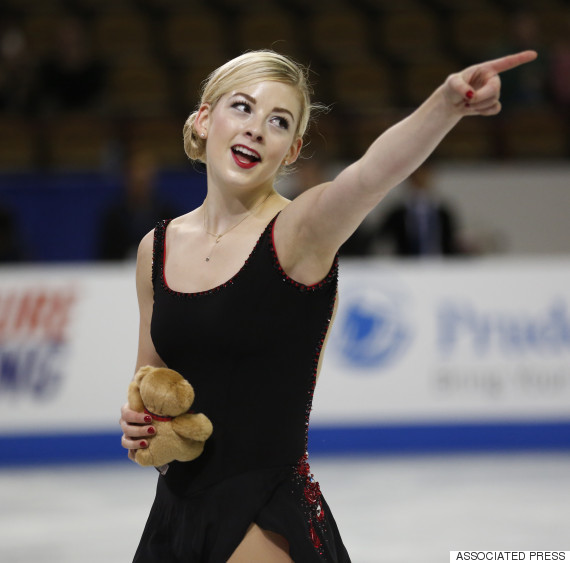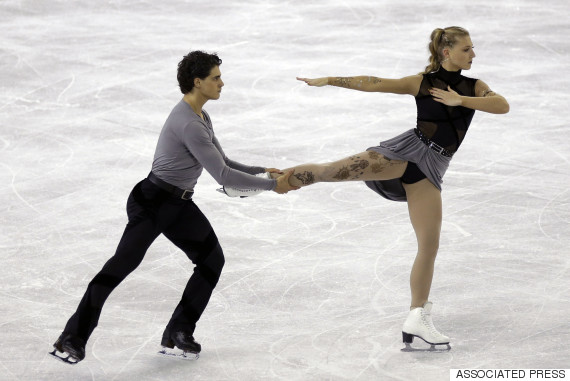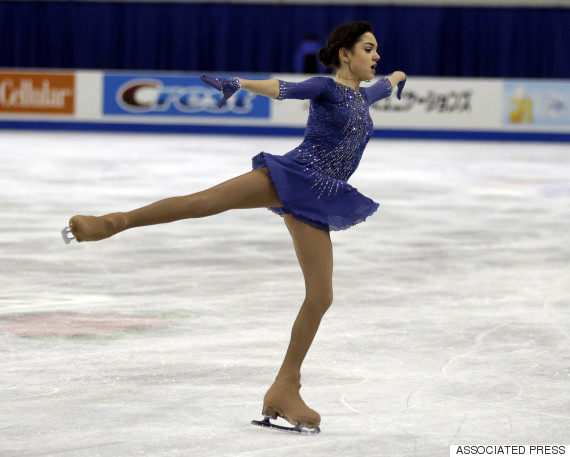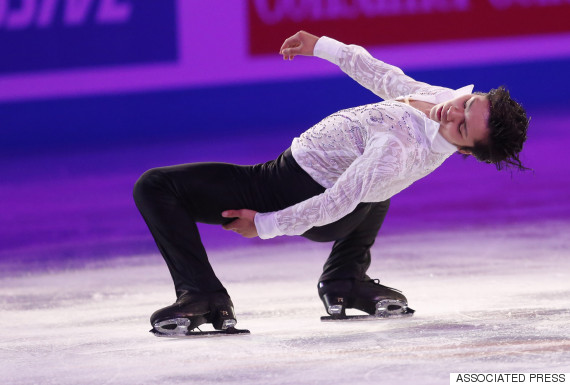Alison McCauley posted a photo:
more here: www.amccauley.ch/albums/hijra-communities-in-mumbai
13 Queer-Friendly Classics for Halloween
Whether they feature persecuted outcasts at odds with society, characters who are subtly or not-so-subtly LGBT, or simply revel in high-camp high jinks, these are the perfect films for your Halloween party or Netflix-and-chill weekend.
Addams Family Values (1993)
Gay screenwriter Paul Rudnick (In & Out) penned this follow-up to 1991’s The Addams Family. As the family welcomes a new baby, the film memorably pits the oddball Addams kids Wednesday and Pugsley (Christina Ricci and Jimmy Workman) against the squeaky-clean WASPs at summer camp.
ParaNorman (2012)
This animated tale of an outcast boy who sees and speaks to ghosts, and must save his town from an ancient witch’s curse, is filled with smart and funny social satire, and includes a delightfully offhand reference to a major character who is gay (no spoilers here).
Edward Scissorhands (1990)
Tim Burton’s funny, poignant, and visually stunning update on the Frankenstein myth stars Johnny Depp as the ultimate outsider with special gifts (including hairdressing and topiary) and an ebullient Winona Ryder as his love interest. It launched a thousand Halloween costumes — and Depp as a mainstream movie star.
Hocus Pocus (1993)
Gay icons Bette Midler, Sarah Jessica Parker, and Kathy Najimy cut the comic ham an inch thick is this high-camp tale of three resurrected witch sisters who wreak Halloween havoc on Salem, Mass.
Carrie (1976)
Sissy Spacek stars as the ultimate bullied teen — who happens to be cursed with telekinetic powers and a Bible-crazy mother (Piper Laurie). It’s a creepy camp classic for the ages — which culminates in the worst prom ever.
A Nightmare on Elm Street 2: Freddy’s Revenge (1985)
As actor Robert Englund (Freddy Krueger) has said, “Nightmare 2 is a very creepy, very kinky film. Instead of having a teenage girl in jeopardy, we have a bisexual male [Mark Patton]. There’s a lot of stuff implied with the S&M bar, stringing up the coach in the shower room bondage situation, going to his boyfriend’s house for protection, and the two of them take their clothes off as often as possible.” Read Mark Patton’s take on the role here.
Cat People (1942)
When a Serbian-born woman falls in love with and marries an American man, their marriage suffers due to an ancient curse; Whenever she’s aroused, she turns into a panther and kills. The first horror film to explore psychosexual themes including repressed lesbianism, it uses atmosphere and suspense rather than explicit shocks or gore.
What Ever Happened to Baby Jane? (1962)
Don’t go trick-or-treating at Baby Jane Hudson’s house. Gay icons Bette Davis and Joan Crawford star in this psychological thriller as a grotesque former child star and her disabled ex-movie star sister. This creepy classic launched an entire genre of faded movie queen horror films.
Bride of Frankenstein (1935)
Gay director James Whale’s sequel to his 1931 classic Frankenstein has kept queer critics busy exploring the film’s gay subtext. The film revels in high-camp humor, it stars gay or bisexual actors Colin Clive (as the good doctor) and Ernest Thesiger (as the “sissified” Dr. Pretorius), and while the match between the monster and his bride is a disaster, the only real love in the film is the poignant tenderness between the monster and the blind hermit.
Sweeney Todd: The Demon Barber of Fleet Street (2007)
Tim Burton’s film version of gay composer Stephen Sondheim’s Broadway musical stars Johnny Depp as the vengeful barber turned serial killer and Helena Bonham Carter as the pie-making gal who loves him. Operatic emotions and cannibalism ensue.
Interview With the Vampire (1994)
Tom Cruise plays the bisexual vampire Lestat, who seduces the tender-hearted Louis (Brad Pitt) into joining him in eternal life. The film is gorgeously grotesque, but why Pitt’s character turns down an offer to spend an eternity with Antonio Banderas in Paris is beyond me.
The Haunting (1963)
In this masterpiece of psychological horror, a paranormal investigator invites a lesbian clairvoyant (Claire Bloom), an emotionally vulnerable psychic (the great Julie Harris), and a skeptical heir (Russ Tamblyn) to stay in an eerie mansion that has a sordid past. Skip the 1999 remake; this is one of the best haunted house flicks of all time.
The Rocky Horror Picture Show (1975)
Every LGBT movie fan owes a great deal to The Rocky Horror Picture Show, which has been responsible for more queer kids coming out than … well, any other film. The campy ode to bisexual kink and sexual freedom is now celebrating its 40th anniversary. Don’t dream it — be it!
In honor of Rocky Horror’s 40th anniversary, cast members Tim Curry, Susan Sarandon, Barry Bostwick, Meat Loaf and Patricia Quinn gathered for a Today show reunion.
Find the films on this list at Can I Stream It?
Which LGBT-friendly films would you recommend to get into the Halloween spirit? Share them with us in the comments section below.
Adam Sandel
www.advocate.com/arts-entertainment/2015/10/27/13-queer-friendly-classics-halloween
Report Finds Just Half Of Americans Are Protected From Anti-LGBT Discrimination At Work
Only half of Americans are protected against anti-LGBT employment discrimination, a report from the Movement Advancement Project found.
According to the study, released Tuesday, 51 percent of the U.S. population lives in cities, states or counties with regulations protecting workers from discrimination against lesbian, gay, bisexual and transgender individuals. These protections explicitly prevent employers from firing workers for their sexual orientation or gender identity.
MAP’s researchers found a significant geographic divide in who is protected at either the state or local level. According to the group’s analysis, employment protections are concentrated in 30 percent of the country geographically, with most non-discrimination ordinances and laws clustered in the West, Midwest and Northeast. The study also found that a LGBT individual living in an urban area is 50 times more likely to be protected against workplace discrimination than a person living in a rural county.
Ineke Mushovic, MAP’s executive director, praised cities and counties for passing key protections for their residents. However, Mushovic said, federal and state-level ordinances are also critical to ensure protections extend beyond urban areas.
“There is a deep rural-urban divide when it comes non-discrimination protections for LGBT people,” Mushovic said in a statement. “Vast geographic stretches in this country — mostly in rural areas — lack LGBT-inclusive nondiscrimination laws. … State and federal-level nondiscrimination laws are also essential to provide protections for everyone.”
A poll released by Public Religion Research Institute in June found that almost 70 percent of Americans support non-discrimination protections. However, the same poll also found that 75 percent of Americans incorrectly believe such discrimination is already outlawed at the federal level.
Federal attempts at passing such legislation have been unsuccessful. In 2013, the Senate passed the Employment Non-Discrimination Act, which would have made it illegal for employers to discriminate against LGBT individuals. However, the GOP-controlled House blocked the legislation.
Earlier this year, Rep. David Cicilline (D-R.I.) and Sen. Jeff Merkley (D-Ore.) introduced the Equality Act, which would amend the 1964 Civil Rights Act to include protections for LGBT individuals. The bill goes beyond employment, also outlawing discrimination in housing, education and public accommodations, and does not include the religious exemptions that ENDA did.
“The time has come for us as a nation to be bolder and better in ensuring full rights for the LGBT community,” Merkley said in a statement in June. “Every person deserves to live free from fear of discrimination, regardless of who they are or whom they love. Enacting the Equality Act will bring us another significant step forward in our nation’s long march towards inclusion and equality. It will extend the full promise of America to every American.”
Read the full MAP report here.
Also on HuffPost:
— This feed and its contents are the property of The Huffington Post, and use is subject to our terms. It may be used for personal consumption, but may not be distributed on a website.
Open Question: Christians can I be Christian if I respect Lgbt people?
I will only be Christian if I am allowed to support and love Lgbt individuals and not judge them. What say ye?
Coming Out to Support LGBTQ Youth

Earlier this month, HRC Mississippi State Director Rob Hill joined State Auditor candidate Joce Pritchett for a panel discussion on National Coming Out Day at Mississippi State University.
HRC.org
www.hrc.org/blog/entry/coming-out-to-support-lgbtq-youth?utm_source=rss&utm_medium=rss-feed
San Francisco’s Mayor Says He’s “Open” To Allowing Bathhouses In The City Again
 After a 30 ban, the city of San Francisco is flirting with the idea of allowing bathhouses again.
After a 30 ban, the city of San Francisco is flirting with the idea of allowing bathhouses again.
In 1984, during the height of the HIV/AIDS epidemic, a San Francisco Superior Court judge effectively banned bathhouses by ordering them to remove all doors from private rooms ostensibly to cut down on opportunities for unprotected intercourse. Since then, enterprising queers have had to find a way to Berkeley’s popular Steamworks or even to San Jose for the Watergarden.
Or make due with the lively SF sex clubs.
Related: Are Gay Bathhouses Going Extinct?
Mayor Ed Lee tells the Bay Area Reporter he is “open” to the idea of doing away with that rule and allowing bathhouses to once again operate within city limits. There’s a catch. Lee says public health officials must be on board, as well.
“The issue about bathhouses and so forth that is an item that blends entertainment along with safe sex,” said Lee. “I have got to have experts telling me that is something they wouldn’t have a problem with. I would be open to it but I have got to have that kind of process.”
Related: After 30 Years, Should San Francisco Allow Gay Bathhouses?
The city recently announced its Getting to Zero initiative, which aims to cut new HIV infections 90 percent over the next five years. The increase in HIV testing and widespread adoption of PrEP has made that goal obtainable. There is concern in some quarters that reopening bathhouses could hurt that initiative.
The City’s Department of Public Health has not changed its position regarding the ban.
Buzz Bense, a former co-owner of Eros, one of the city’s last remaining gay sex clubs, predicts the City’s Department of Public Health will never get on board.
Related: Five Reasons Why San Francisco’s Gay Sex Clubs May Soon Be Extinct
“This isn’t about health science,” he claims. “It is about politics.”
There’s another more practical reason it might not happen anytime soon. Given the skyrocketing price of SF real estate, potential operators would be hard-pressed to find a convenient location for such a modern facility, although, presumably, demand would be high after years without a true bathhouse in the world’s gay sex mecca–even in the age of hookup apps.
Eros, a sprawling two floor space on the edge of the Castro, could presumably be reconfigured with private rooms rather than bunk beds and communal spaces open to all.
“Where the fuck can you buy a big building for less than a gillion dollars to open a bathhouse?” Bense asked.
Related: PHOTOS: A Rare Glimpse Into San Francisco’s Infamous Fairoaks Bathhouse
Graham Gremore
Ben Whishaw Stars in BBC Romance Drama About a Gay Spy: WATCH

Out gay actor Ben Whishaw is returning to television as a romantic young gay man drawn into the nefarious world of espionage in London Spy, a five-part miniseries airing this month on BBC America.
London Spy is the story of a chance romance between two people from very different worlds, one from the headquarters of the Secret Intelligence Service, the other from a world of clubbing and youthful excess.
Whishaw plays Danny – gregarious, hedonistic, romantic and adrift, who falls for the anti-social enigmatic and brilliant Alex (played by [Edward] Holcroft). Just as the two of them realise that they’re perfect for each other, Alex is found dead. Danny, utterly ill-equipped to take on the complex and codified world of British espionage, must decide whether he’s prepared to fight for the truth.
You may recall Holcroft from this watery scene in Kingsman: The Secret Service.

We first reported on news of Whishaw’s casting in London Spy late last year. Whishaw came out as gay and married in August of 2013.
London Spy was penned by gay writer Tom Rob Smith and directed by by Jakob Verbruggen (The Fall) and promises a good dose of dark and twisty intrigue, if the trailer can be believed.


Charlotte Rampling and Jim Broadbent also star.
Watch the trailer below:
The post Ben Whishaw Stars in BBC Romance Drama About a Gay Spy: WATCH appeared first on Towleroad.
Sean Mandell
Ben Whishaw Stars in BBC Romance Drama About a Gay Spy: WATCH
Intersex Veteran Denied Passport For Refusing to Choose Gender, Files Lawsuit
An intersex person from Colorado who identifies as neither male nor female is suing the U.S. State Department after being denied a passport after they refused to select a gender on the application.
Dana Zzyym, a U.S. Navy veteran, claims the application violates the Constitution, Reuters reported Monday. Zzyym confirmed with The Advocate that they prefer the gender-neutral pronouns they, them, and their to refer to themselves.
Zzyym filed a federal discrimination lawsuit in Denver this week, stating it was a constitutional violation to force an intersex person to select a gender in order to travel abroad. At the time, they were trying to travel to Mexico City for the International Intersex Forum, according to Reuters.
“I am not male, I am not female, I am intersex, and I shouldn’t have to choose a gender marker for my official U.S. identity document that isn’t me,” Zzyym said in a statement obtained by Reuters.
Countries such as Malta, India, Nepal, Australia, and New Zealand provide a third gender option on passports, and some nations are considering making a similar change, Kyle Knight wrote in The Advocate this week.
Zzyym’s complaint said that at birth in 1958, they had “ambiguous external sex characteristics,” and the gender box on their birth certificate was initially left blank, the wire service reported.
They were raised as a boy. “Similar to many other intersex children, by age five, Dana had been subjected to several irreversible, invasive, painful, and medically unnecessary surgeries designed to make Dana’s body conform to binary sex stereotypes,” the complaint said, according to Reuters.
Zzyym joined the U.S. Navy in 1978 and served as a machinist mate during several tours of duty, but left in 1984 and decided to explore their gender identity.
After living as a woman, which didn’t feel right, they adopted the name Dana Zzyym and determined gender identification was “arbitrary,” the suit reportedly said.
Zzyym’s lawyer, Paul Castillo of Lambda Legal, told Reuters his client isn’t seeking compensation, but merely to force a change in U.S. policy.
“Dana is being deprived of the right to lawfully exit the United States because of personal characteristics, and that’s discrimination, pure and simple,” Castillo told Reuters.
Elizabeth Daley
I'm Tired of Pretending Figure Skating Isn't the Best Sport Ever (But It Needs Help)
I remember my first time watching figure skating with eerie clarity.
February 1994. Like millions upon millions of other people around the world, my 9-year-old eyes were glued to the television to watch the skating competitions during the Olympic Games in Lilllehammer, Norway. I distinctly remember Tonya Harding’s skate lace meltdown, Nancy Kerrigan’s twinkling beige dress and Scott Hamilton’s commentary yelping exuberantly about it all.
I was totally hooked. In the years that followed, I began to obsessively follow every competition and show on TV, filling up hundreds of blank VHS tapes so that I could re-watch Michelle Kwan’s every moment of glory whenever I wished. (Oh, the days before DVR.) I also attended dozens of events in person, including the Olympic-qualifier national championships in St. Louis in 2006.
After that, my interest waned. At the same time, figure skating’s popularity in the United States has plummeted. While endless hours of skating coverage used to fill the airwaves, just more than a handful of events are broadcast on network television today. And while the sport is more popular than ever in Asia, it has been on steady decline here for years, retreating into obscurity.
Almost more than a decade since my last live event, I attended the Skate America competition in Milwaukee, Wisconsin last weekend.

Kicking off the six-part Grand Prix international series, Skate America is the first major competition of the figure skating season. It’s an important event, where skaters earn points toward their goal of qualifying for the Grand Prix Final, a competition that serves as a lucrative preview of the World Championships in the spring. But you wouldn’t necessarily know that by looking around the half-empty stands at the UW Milwaukee Panther Arena.
With a 7,000-person capacity for figure skating events, the Panther Arena attracted, at its best-attended of four ticketed sessions, an audience only half that size. The event’s first session of four, Friday afternoon, was attended by only 2,700.
Skate Americas as recently as 2008 have enjoyed a total attendance as high as nearly 30,000 for the full multi-day event, so where was everyone?
I have a few thoughts on where the gangly cousin of the American sports family went wrong, and how it can regain cultural relevancy anew:
1. Celebrate the sport for what it is, rather than making it something it’s not.
Let’s get the obvious out of the way: The action on the ice all weekend was remarkable. The achievements of top figure skaters, combining the athletic skill required, the strength and agility, with the artistry of performance factor is a tall order. Few achieve the rare moments of transcendence when it all falls into place all at once. On top of that, the costumes are stunning, often more intricate than the outfits worn by many pop stars on their arena tours, and the drama between rival skaters, coaches and nations is palpable.
All things considered, figure skating is the original reality show. And that’s enough to let the sport, in many ways, speak for itself. It doesn’t need an in-arena DJ spinning pop and hip-hop all weekend long during breaks and between performances. It doesn’t need an in-arena host leading awkward trivia contests with fans. Just let the skaters skate — and find a way to make it easier for interested viewers to find it on television. Only one hour of the event was broadcast on its network partner, NBC, over the weekend. This is insufficient exposure to build an audience.

2. But can we talk about the scoring system?
For anyone who hasn’t watched figure skating in a long time, the days of a 6.0 marking a perfect score ended about a decade ago. The sport’s new judging system assigns different point values to each move performed — the harder it is, the more points you get — and bonus points are offered, or taken away, based on how well it was executed. This means that a “good” score means something different for each skater, depending on what they planned to perform.
The winning total for Skate America’s women’s champion, Russia’s Evgenia Medvedeva, was 206.01. That number is meaningless to the average person. Context is needed to educate viewers about what factors contributed to a skater’s score being either low or high, why a skater who fell on a jump might still place high based on their overall performance, for example. To avoid fully explaining so, both on television and especially at a live event, causes only confusion. This is already a kind of ridiculous sport, let’s not make it more so!

3. But don’t dumb it down.
While context is important, don’t assume an audience is completely clueless. During one in-arena interview with a former champion about what to expect during the pairs event that was broadcast on the arena Jumbotron, the commentator explained that the male pairs skaters were throwing their partners the length of a couch during their throw jumps. That comparison is meaningless to the scoring system and somewhat demeaning to the audience.
More thorough commentary might have noted the difference in difficulty and point value of different throw jumps, which jumps top pairs were planning for their programs and how much of a role successful completion of their throw jumps plays in a pairs team’s overall performance.
4. Send in the music consultants.
Beginning last year, the figure skating powers that be allowed, for the first time, all four disciplines of skating — pairs, men’s, ice dancing and women’s — to use music with lyrics for their programs. One would think this would open the floodgates to all sorts of different music being used in competition but, for the most part, most skaters continue to stick to generic, conservative musical selections that serve as Ambien for audiences.
At Skate America, the musical selections for the men’s final were almost entirely dreary, ranging mostly from dirge-y movie soundtracks like The Piano and The Mission to tinkly, piano or string-heavy ballads. The uniformly dreary music created a low-energy vibe in the arena and, had it been on television, likely would have turned away viewers. Many of the musical selections among the ice dancers were similarly lacking in excitement, but more unexpected, energetic and diverse music choices could make a huge impact. (I heard enough Il Divo this weekend to last a lifetime.)

5. The sport is at its best at its most eccentric. Embrace and encourage that.
The weekend’s highlights were the moments where a skater stuck out from the crowd. Pairs champions Wenjing Sui and Cong Han of China’s incredible lateral quadruple twist. Men’s runner-up Shoma Uno of Japan’s unusual, program-ending cantilever bend. Canadian ice dancers Piper Gilles and Paul Poirier’s strange and exciting “She Said/Neverland” free dance.
These are the sorts of moments that fans of the sport from long ago, the days of Tonya and Nancy, will be drawn to if given the chance. These are the moments skating promoters in the U.S. need to be emphasizing if they are to bring the sport back from its death spiral.
— This feed and its contents are the property of The Huffington Post, and use is subject to our terms. It may be used for personal consumption, but may not be distributed on a website.
Open Question: Why do Christians get upset when you say they are confused or deluded or suffer from a mental illness?
Some Christians claim that Lgbt people are delusional, confused or suffer from mental illnesses and to them it’s ok saying it. If however I say the same thing to Christians they say I’m evil and to go away or generally lash out.
You must be 18 years old or older to chat